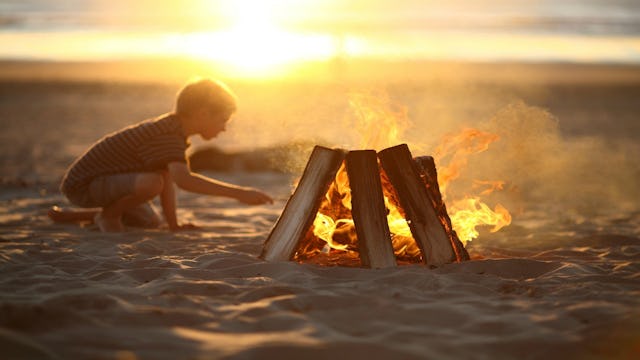Why Your Kids Should Be Playing With Fire

At the tender age of 7, one of my sons asked me to buy him a flint fire starter. I honestly had no clue what that even was, but after he explained that it was a more reliable alternative to matches, I didn’t hesitate.
I had no worries about him catching the house on fire, or setting the backyard ablaze, because since he was able to stand and walk, he has been witness to his parents and brothers in and around campfires and grill cooking fires. From a very early age, he had watched how we started, kept, and put out fires in a safe and responsible manner, and he saw what the ability of having a campfire gave us — warmth and hot food, just to name a few.
And yet most parents of young children are more than just a little hesitant to talk about and make fires with their kids. Most of the time they downright prohibit them. It just adds to the ridiculousness of modern parenting — where parents feel it’s their ultimate duty to shield and protect their kids from any and all dangers, risks, or hazards — with fire being right up there as one with potentially the most deadly of consequences.
But parenting experts remain keen on the fact that it’s not only necessary to expose our kids to risks of all kinds (think unsupervised and non-traditional playgrounds), but to teach them the proper way to manage and experience those risks instead of avoiding them altogether. And learning about fire, and being comfortable around it is no different. In fact, knowing how to safely and effectively use and handle fire is an essential life skill for a multitude of reasons.
But it’s not enough to just teach basic fire safety and tell our kids to never play with matches. We need to show them how to use matches (and other fire starters), and teach them that they’re fundamental and vital tools that have helped sustain humanity since the dawn of time.
Tony Deis is the co-founder of Oregon’s Trackers Earth, a “forest school” that prides itself on teaching about the world by actually getting out in it and experiencing it. He believes that exposing kids to so called “dangerous tools,” like matches, gives them the experience they need to better handle those tools as teens and adults. He states, “My experience has been, when you teach a child how to use tools, they respect the boundaries and responsibilities associated with them. It’s something innate. It gives them an incredible survival tool.”
Deis goes on to add that we need to teach our kids that fire and fire-starting tools are not something to be scared of, and that fire can be used to teach not only survival concepts, but science concepts as well. We can teach thermodynamics, the chemical changes that happen when we heat food and boil water, and how the heat from fire can be used as a tool itself — shaping and carving weaponry, for example. He says, “The more you add the practical applications, the more kids get excited about it.”
So when are we supposed to introduce matches and fire to our children? Deis says that as soon as they’re physically able to strike a match, they should. Yes, this means your toddler should be watching you properly and successfully build a fire, and then as soon as their physical capabilities allow them to, they should be able to do it on their own. He encourages adults to first model safe fire-building practices, and then to supervise their children until they’re able to do it on their own. This may seem wild to parents, but Deis also says to allow children to explore the area around their fire, and as long as it’s environmentally safe, to show children how to burn other items.
If you’ve grown up camping with your small children, or have been involved in scouting, this all seems like totally normal behavior — as it should be. But if you haven’t, now may be a good time to embrace your inner fire starter, and take the time to teach your kids about how being able to start and maintain a fire could one day save their life.
While playing with matches without being taught to respect them can be dangerous, the inability to know how to use them when you really need to, can be even more dangerous.
This article was originally published on